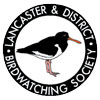Home › Forums › Bird & Insect Sightings › Bits and bobs
-
AuthorPosts
-
All the usual garden suspects in Freehold this week topped up with a passing treecreeper and a pair of bullfinch. After a few days silence in the cold, the song thrushes fired up again about Wednesday. Over-flyers include the regular male sparrowhawk (which often does a lot of hunting quite late into the dusk), a pair of raven on three occasions commuting between the hills and the shore, and a single very dark, almost black, buzzard heading purposefully toward Quernmore from Morecambe without gliding or soaring at all.
An interesting (well, for me in lockdown at least) observation this week is the different methods used to eat fatballs on the ground. The blackbird chisels at it and eats the crumbs, a jay examines the fatball and hops around it but doesn’t approach, treating it suspiciously like an unexploded bomb. Robins and dunnocks peck at it, but only after thev’ve had an ‘opening’ made for them by bigger birds. Feral pigeons walk all around the ball picking up stray crumbs but seem oblivious to the ball itself. Jackdaws hold the ball down with one foot to stop it rolling away then chisel it like a woodpecker. Some jackdaws favour their left foot, others the right ( there are 3 with distinctive plumage faults I can recognise). The experiment usually ends when a lesser black backed gull lands and swallows the fatball whole.
It’s actually worth noting the number of jackdaws in Freehold. They are a common bird that often goes under the radar. My maximum count is around 80 – 90 birds which take advantage of the chimneys to nest. The vast majority of all the chimneys are unused now so this must be a major factor in their success. Going by the amount of time they spend just mucking about in the sky chasing each other, they must be exceptionally efficient feeders and commute a fair distance. They are distinctive in that although the flock fly in a close grouping of often 60 or more, mated pairs always fly together so the effect is a squadron of matched pairs.
-
AuthorPosts
- You must be logged in to reply to this topic.
